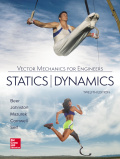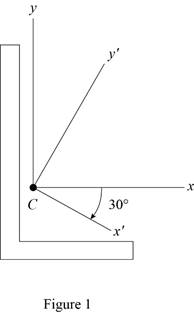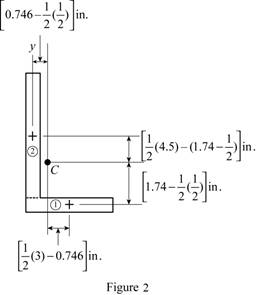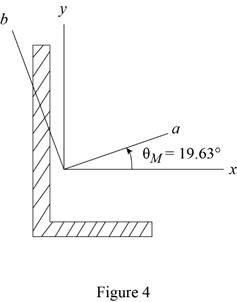
Find the moment and product of inertia of the area with respect to x and y axes about through
Answer to Problem 9.192RP
The moment of inertia of the area with respect to x about through
The moment of inertia of the area with respect to y about through
The product of inertia of the area with respect to x and y axes about through
Explanation of Solution
Sketch the cross section as shown in Figure 1.

Refer to Figure 9.13.
The moment of inertia
The moment of inertia
Refer to Problem 9.191.
Sketch the cross section as shown in Figure 2.

Express the product of inertia as shown below:
Here,
Applying parallel axis theorem,
When the x and y axis is symmetry.
Refer to Figure 1.
Find the area of semicircle section 1 as shown below:
Here,
Substitute
Find the area of rectangle section 2 as shown below:
Here,
Substitute
Find the centroid for section 1 about x axis
Find the centroid for section 1 about x axis
Find the centroid for section 1 about y axis
Find the centroid for section 2 about x axis
Find the product of inertia of the area with respect to x and y axes by using parallel axis theorem as shown below:
Substitute
The Mohr circle is defined by the diameter XY, where
Find the average moment of inertia
Here,
Substitute
Find the radius (R) using the relation as shown below:
Here, R is radius and
Substitute
Sketch the Mohr circle as shown in Figure 3.

Refer to Figure 2.
Substitute
Find the angle
Find the moment of inertia of the area with respect to x about through
Here,
Substitute
Thus, the moment of inertia of the area with respect to x about through
Find the moment of inertia of the area with respect to y about through
Substitute
Thus, the moment of inertia of the area with respect to y about through
Find the product of inertia of the area with respect to y about through
Substitute
Thus, the product of inertia of the area with respect to x and y axes about through
(b)
Find the orientation of the principal axes through the centroid and corresponding values.
(b)
Answer to Problem 9.192RP
The orientation of the principal axes at the origin is
The maximum moment of inertia is
The minimum moment of inertia is
Explanation of Solution
Calculation:
Find the orientation of the principal axes through at origin as shown below.
Refer part a.
Thus, the orientation of the principal axes at the origin is
Sketch the orientation axis as shown in Figure 4.

Find the maximum moment
Substitute
Thus, the maximum moment of inertia is
Find the minimum moment
Substitute
Thus, the minimum moment of inertia is
Want to see more full solutions like this?
Chapter 9 Solutions
Vector Mechanics for Engineers: Statics and Dynamics
- Considering L = 50 + a + 2·b + c {mm}, determine the centroidal coordinate Ycg (location of the x´ axis of the centroid) and the moment of inertia is relative to the X´ axis (IX' , ). Assume a minimum precision of 6 significant figures and present the results of the moments of inertia in scientific notation (1.23456·10n ). (Knowing that a=7, b=1, and c=1.) Ycg = IX, =arrow_forwardUsing the polar moment of inertia of the isosceles triangle of Prob. 9.28, show that the centroidal polar moment of inertia of a circular area of radius r is π4/2. ( Hint: As a circular area is divided into an increasing number of equal circular sectors, what is the approximate shape of each circular sector?)(Reference to Problem 9.28):Determine the polar moment of inertia and the polar radius of gyration of the isosceles triangle shown with respect to point O.arrow_forwardFor the figure shown knowing that a = 1.00 cm and b = 4.00 cm, determine:(a) The centroid of the figure shown.b) The moments of inertia Ix and Iy and the product of inertia Ixy about the x and y axes.c) The angle m corresponding to the location of the principal axes.d) For the u-v axes shown and obtained by rotating an angle = 34.0° clockwise, the corresponding momentsand product of inertia using Mohr's circle.arrow_forward
- Determine by direct integration the moment of inertia of the shaded area with respect to the y axis.Fig. P9.14arrow_forwarddetermine the centroidal polar moment of inertia of a rectangle 100mm wide by 200 mm higharrow_forwardDetermine by direct integration the moment of inertia of the shaded area with respect to the x axis.Fig. P9.11arrow_forward
- A channel and a plate are welded together as shown to form a section that is symmetrical with respect to the y axis. Determine the moments of inertia of the combined section with respect to its centroidal x and y axes.arrow_forwardTwo L4 x 4 x 1/2-in angles are welded to a steel plate as shown. Determine the moments of inertia of the combined section with respect to centroidal axes respectively parallel and perpendicular to the plate.arrow_forwardFor the area indicated, determine the orientation of the principal axes at the origin and the corresponding values of the moments of inertia.Area of Prob. 9.73(Reference to Problem 9.73):Using the parallel-axis theorem, determine the product of inertia of the area shown with respect to the centroidal x and y axes.arrow_forward
- A built-up section fabricated by attaching a C180x15 to a W250x18 shape with 15 mm rivets as shown. Determine the moment of inertia at the centroid of the built-up section. Answer: Centroidal moment of inertia along x-axis= 48.857x106mm4 Need the complete solution, thanks!arrow_forwardDetermine the moments of inertia and the product of inertia of the L3 x 2 x 1/4-14 angle cross section of Prob. 9.74 with respect to new centroidal axes obtained by rotating the x and y axes 30° clockwise.(Reference to Problem 9.75):Using the parallel-axis theorem, determine the product of inertia of the area shown with respect to the centroidal x and y axes.arrow_forwardThe moments and product of inertia of an L4 x 3 x 1/4-in. angle cross section with respect to two rectangular axes x and y through C are, respectively, Ix = 1.33 in4. Iy = 2.75 in4, and Ixy <0, with the minimum value of the moment of inertia of the area with respect to any axis through C being Imim = 0.692 in 4 Using Mohr’s circle, determine (a) the product of inertia Ixy of the area, (b) the orientation of the principal axes, (c) the value of Imax.arrow_forward
 Elements Of ElectromagneticsMechanical EngineeringISBN:9780190698614Author:Sadiku, Matthew N. O.Publisher:Oxford University Press
Elements Of ElectromagneticsMechanical EngineeringISBN:9780190698614Author:Sadiku, Matthew N. O.Publisher:Oxford University Press Mechanics of Materials (10th Edition)Mechanical EngineeringISBN:9780134319650Author:Russell C. HibbelerPublisher:PEARSON
Mechanics of Materials (10th Edition)Mechanical EngineeringISBN:9780134319650Author:Russell C. HibbelerPublisher:PEARSON Thermodynamics: An Engineering ApproachMechanical EngineeringISBN:9781259822674Author:Yunus A. Cengel Dr., Michael A. BolesPublisher:McGraw-Hill Education
Thermodynamics: An Engineering ApproachMechanical EngineeringISBN:9781259822674Author:Yunus A. Cengel Dr., Michael A. BolesPublisher:McGraw-Hill Education Control Systems EngineeringMechanical EngineeringISBN:9781118170519Author:Norman S. NisePublisher:WILEY
Control Systems EngineeringMechanical EngineeringISBN:9781118170519Author:Norman S. NisePublisher:WILEY Mechanics of Materials (MindTap Course List)Mechanical EngineeringISBN:9781337093347Author:Barry J. Goodno, James M. GerePublisher:Cengage Learning
Mechanics of Materials (MindTap Course List)Mechanical EngineeringISBN:9781337093347Author:Barry J. Goodno, James M. GerePublisher:Cengage Learning Engineering Mechanics: StaticsMechanical EngineeringISBN:9781118807330Author:James L. Meriam, L. G. Kraige, J. N. BoltonPublisher:WILEY
Engineering Mechanics: StaticsMechanical EngineeringISBN:9781118807330Author:James L. Meriam, L. G. Kraige, J. N. BoltonPublisher:WILEY





